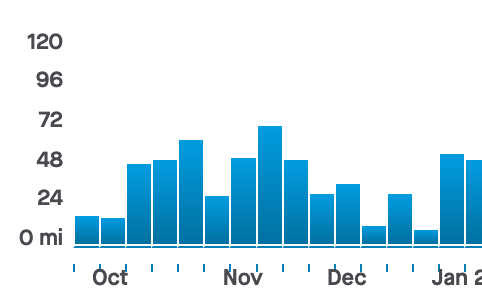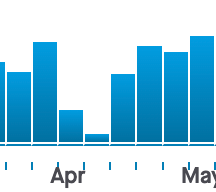From Sisyphean Training to Strategic Recovery

How I Embrace the 3-Weeks-On, 1-Week-Off Formula for Marathon Success
I follow a 3-weeks-on, 1-week-off in my current training for the 2023 California International Marathon (CIM) in Sacramento. Let's examine my weekly volume over the past three years to understand this pattern.

In the dark days of 2020-2021 I made a common running mistake. I was running with too much intensity. Most of my time was spent at the top of zone two and in zone three. These zones represent percentages of maximum heart rate. In zone two, conversation should be unlabored. A marathon effort will be at the top of zone two and zone three.
Back then, my weekly mileage peaked in the low fifties, but more often than not I was in the thirty to forty mile range. But, because most of my runs were run at what was actually a marathon effort, they were not as productive as I thought they were.
As an example, almost exactly two years ago, I ran 16 miles at a 9:00 min / mi pace. My average HR was 152 bpm (solidly zone three). This would be an absurd workout for me to do today. It's not that I can't run 16 miles in 2 hours and 23 minutes. It's that this level of effort does not have a commensurate fitness gain.
At that intensity level the amount of damage I'm doing to my body requires a period of recovery that offsets the entirety of the workout's benefit. This is Sisyphean training. It is pushing a large boulder up a hill only to have it roll back down for all eternity. And that's only if you fully recover. Without full recovery, overtraining will ensue and with it will come poor sleep, a weakened immune system, and injury.
Had I raced in 2020, I might have learned this lesson sooner. A marathon is an incredible teacher.
In 2021 I did get a lesson in the form of the first Boulderthon - my slowest marathon race. You can see it in the 2021-22 mileage graph. It's the fourth bar, just before the 0 mileage week.

Sadly, I drew the wrong lesson. After Boulderthon, I decided to run more miles, but without sufficiently decreasing my intensity. I thought at the time that I just needed to be very consistent.
Between December 2021 and June 2022, my consistent training reflected that understanding. I steadily increased my mileage peaking at 71.9 miles in May. But I was racing my speed work. The result was that I was chronically overtrained.
For example, on February 25, 2022 I ran five 1k repeats between 6:27 and 6:37. My PR (set just over a month ago) for a 5k is a 6:58 pace. This means that even if I was as good at running then as I am now (I was not) I was running my 1k repeats sometimes 30 seconds per mile faster than my 5k race pace. This is absolutely psychotic.
Attempting this workout today, I'd go a minute per mile slower for better results. I'd still be exercising my VO2 max, but I'd also not be destroying my body in the process. I'd live to train another day.
In April 2022 I had my fastest half marathon in nearly a decade. This just made me double down on my training methodology - lots of miles, lots of effort. But in June of 2021 I learned another lesson from the Revel Rockies marathon.
After 7 months of consistent 45 miles per week or higher training, I had a very disappointing Revel performance. While I was much faster than my previous marathon, I was still about 20 minutes off my goal which means I overestimated my fitness. This tracks with how I was running my workouts - assuming I was faster than I was.
In July of 2022 I got Covid, but then I went back to business as usual. Then in September I got some weird toe pain. You can see the remaining training from October until December, when I ran the 2022 CIM. It is all over the place.

CIM 2022 taught me to assess my fitness more accurately, so I no longer run with 2020-22's intensity. Instead I use use a 3-weeks-on, 1-week-off cycle. You can see this starting in January of 2023 below.

For three weeks, I focus on high volume, typically with speed work. Then I take one week where I do about 40 miles and zero speed work, which is around a 30% volume reduction.
But what happened in April 2023? That's true there is a bit of a dip there. My problem was that I went skiing, but maintained my milage.

I incorrectly assumed that skiing and running used different mana pools. As a result I had some shin tenderness and with pacing the Colfax marathon and racing the Bolder Boulder it took me until June to get back into my 3-1 cycle. The ski issue also helped me understand the importance of looking at rolling mileage in addition to weekly volume.
My training plan is 189 days leading into CIM 2023 in December. I have just 76 days until the race. But, I'm feeling confident. I'm keeping my workouts in check. I've cut down on speed work and the speed work I do is at a much lower intensity than what I was running two years ago. I'm religiously taking rest weeks every fourth week to make sure that I can consolidate my gains.
We'll see what happens in December.
Member discussion